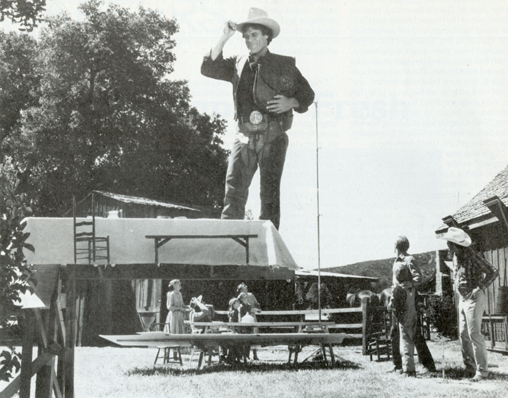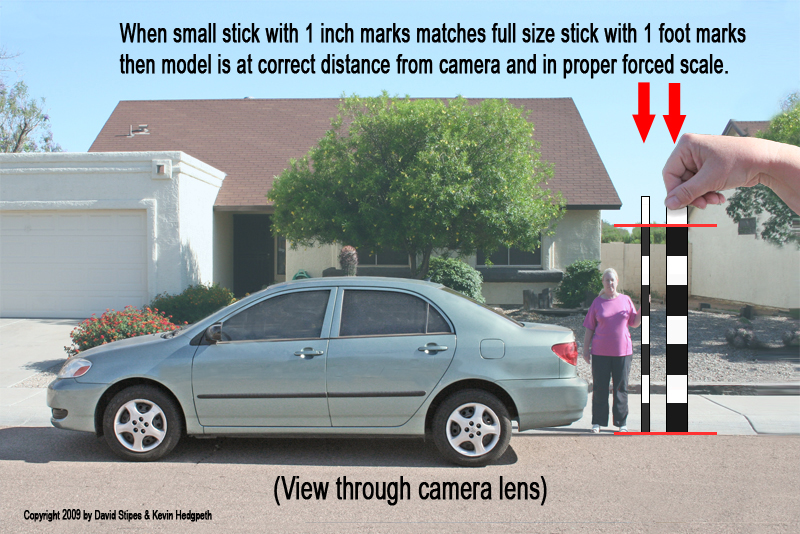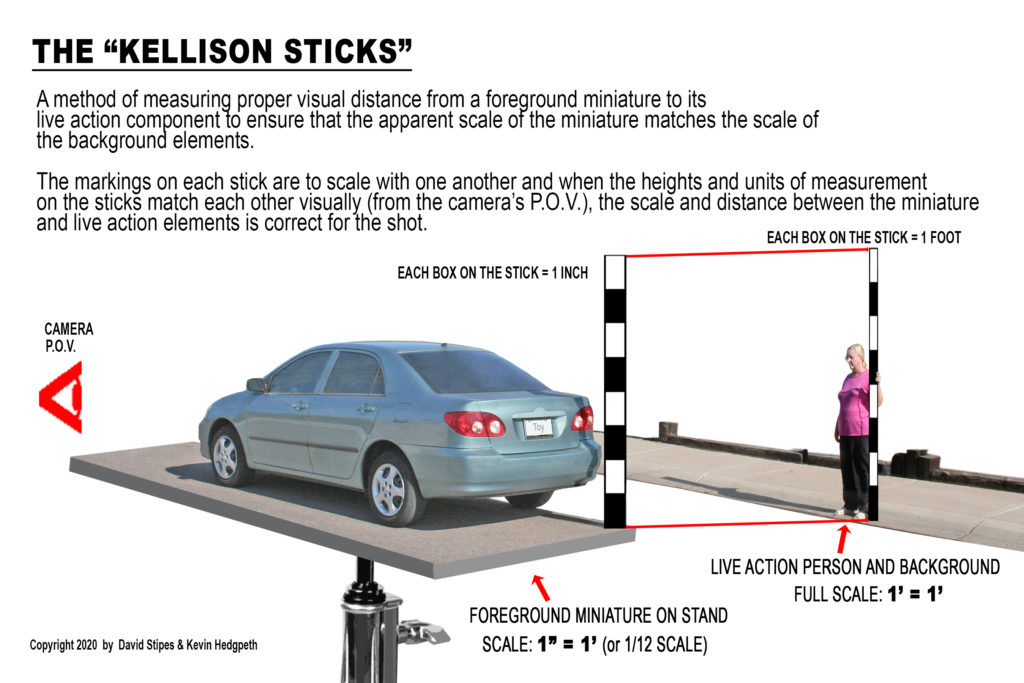-
Phil Kellison makes forced perspective easier
Posted on October 24th, 2009 No commentsPhil Kellison was one of the unsung greats in the visual effects business. He was a visual effects supervisor and designer long before that position was acknowledged in movie credits. He had an almost 40-year career that ranged from the George Pal Puppetoons to industrial films, commercials, and feature films. He had that unusual aptitude of being both the right-brained artist and the left-brained engineer.
Phil was the supervisor and boss at Cascade Picture of California when I began working there in 1969-70. I learned a lot by watching and listening to him. Phil loved the challenge of doing visual effects in-camera and his specialty was forced perspective (more correctly known now as “mixed scale”.) To market the technique to the T.V. commercial business, he dubbed it “Magnascope”.

The Jolly Rancher as seen through the camera.
Forced perspective (mixed scale) usually involves creating a scale model and placing it in front of a live-action scene and lining it up so it appears to be a natural part of the shot. One challenge was to get the model at the correct distance from the camera so it was not too large or too small to fit correctly into the background.

How it was set up. The Jolly Rancher actor is closer to the camera with a miniature table, chair, and bench. The tall pole was used as an eyeline guide for regular-sized actors.
The correct model distance placement can be solved with math and a tape measure or you can use the cool trick Phil had to make this easier. Phil used what I have affectionately called “The Kellison Sticks“
The key is to build your miniature to a scale; for example, 1 inch = 1 foot or 1/12th scale. So, if you needed a model car in the foreground and a real car is ten feet long then a 1/12th scale model of that car would be ten inches long.
Do be aware that there will come a point where a tiny foreground miniature is impractical due to limited detail and lens focus issues. Larger is usually better than smaller.
To make Kellison Sticks, get a length of board like a 1″x 4″ or a 1″x 6″ by say, 8 ft long. Paint the board with alternating one-foot segments of white and black. Now make a scaled-down version of this board with alternating black and white segments. For example, if you are working 1″=1′ then your scaled board would be eight inches long with one-inch segments. At a scale of ½” = 1′ your stick would be four inched long with segments of ½ inch each. Now you have your “Kellison Sticks.”
To line up your miniature, have a person hold the full-sized black and white painted Kellison Stick at the edge of the live set where the foreground miniature will line up with the background. Place your scaled-down Kellison Stick at the back edge of the foreground model.
With someone looking through the lens, move the miniature toward or away from the camera until your scaled-down Kellison Stick matches the full-sized Kellison Stick through the camera. There, you have the correct distance!
 (Jolly Rancher photo examples courtesy of Cinemagic Magazine. All material is for educational use only. All copyrights are retained by their owners. No copyright infringement is implied or intended.)
educational, Film & VFX history, Forced Perspective & Foreground Miniatures, Visual Effects Techniques Cascade, commercials, David Stipes, educational, Forced Perspective, Kellison Sticks, Phil Kellison, Tutorials, Visual Effects Techniques
(Jolly Rancher photo examples courtesy of Cinemagic Magazine. All material is for educational use only. All copyrights are retained by their owners. No copyright infringement is implied or intended.)
educational, Film & VFX history, Forced Perspective & Foreground Miniatures, Visual Effects Techniques Cascade, commercials, David Stipes, educational, Forced Perspective, Kellison Sticks, Phil Kellison, Tutorials, Visual Effects Techniques25 responses to “Phil Kellison makes forced perspective easier”
-
Very Nice!!! Going to make a set for myself to show to my class… Thank You Very Much, David, for posting this… and for letting me know… I sincerely appreciate all of your help, insight, and encouragement…
-
Hey Eric,
Glad you liked the article! I wanted this trick to be saved for the new generation of vis efx students. Let me know how it goes in your classes.
-
This is a really cool technique. I love the fact that the Lord of the Rings, with their massive budget, used the old tried and true methods of forced perspective to help them shoot many of the hobbit and big people shots.
I apprectiate that filmmakers, or enough of them, are still finding uses for effects that don’t involve a computer. For example, I am a huge fan of the guy-in-a-suit. Not that the CGI marionette doesn’t have its place, but it must be done extremely well done. The T-Rex from Jurassic Park comes immediately to mind. It still holds up very well. Unless I am mistaken, most of the animators were stop-motion guys. Perhaps you can correct me on that one.
Thanks again for posting such cool information…its a great educational supplement from someone who was there.
-
Hey Tyler,
I’m glad you like the info! You are one of the new guys likely to put it to good use!
The stop motion guys eventually had to learn the computer approach to stay viable.
There was a transition time where Phil Tippett’s team did stop motion animation with special armatures called D.I.D.s or “digital input devices.” They were stop motion armatures with electronic sensors at the joints that could input the frame-by-frame motion from the manual stop motion animation into the computer.
-
Mark R. Leins October 25th, 2009 at 07:52
I love these old techniques! Simple, effective solutions to great looking VFX shots.
Wasn’t Phil Kellison ultimately at Coast Effects on Lankershim in N. Hollywood? Or, am I thinking someone else? I never got to work with him while in the business, although I picked up a camera package for return from Coast once (I started out of film school as a driver at Hill Prod Service).
Great blog!
-
Hello Mark,
Thank you for joining. Yes, the same. I believe Phil retired from the business when Coast Effects closed.
-
AH, those sticks are great! I did an Sup8mm film called Attack of the Racal Robots, using like 30 of these lil’ wind-up toy robots about an inch high. Those Kellison Sticks would have come in handy! DOF was rough, as well.
My dad was the first to introduce me to FP. We used to take these still FP shots of my brother holding me in his hand (or vise-versa). Those were such fun! My dad used to do the same kind of FP shots with his bro and dad when he was a kid.
FP is so much fun to work with! A real staple to this day in VFX. Thanks for the post, David! 🙂
LLP,
deg -
Hey Deg,
Glad you liked the post! Your dad sounds cool. I get to mess with various effects with my son, too. :^)
-
Wesley December 12th, 2009 at 20:47
One of the most startling shots for me was used in the James Bond movie, “The Living Daylights”. Foreground Miniatures are a staple to the Bond franchise, but I had never suspected the scene where the Soviets chase the resistance fighters across the bridge until I watched the making of documentary. I was stunned when I found out that the bridge was barely five feet high and I was actually looking at a scale model with that included a river made out of saran wrap!
-
Joe Bauer December 30th, 2009 at 08:23
Wow my brain would have hurt alot less setting up the forced persp shots in Elf if I’d had some kellison sticks! We used 4′ cutouts of will ferrell which made the whole thingsort of approximate. Fortunately Rusty Smith the prod designer built the scaled partial set pieces correctly so stacked elements lined up great. We got pretty fast at it, sometimes hitting 30+ set ups in a day!
-
Hey Joe!
Thank you for joining us here! I am delighted to hear from you!
30 perspective set-up / day … you were working really fast!
I have included the link to your on-line interview.
Do you have any additional pointers or procedures that you would be willing to share with us?
Thank you for all the great work you do!
-
Joe Bauer December 30th, 2009 at 23:46
The thing I should add is that after the vfx crew and production designer, art department, costumers etc all do their jobs, it’s really up to a skillful director of photography to match lighting levels front to back, and to achieve a stop that will carry focus deep enough to hold all elements. On Elf our DP, Greg Gardener, had been a gaffer previously, with credits including Repo Man. He is thorough and extremely talented. Greg was fast and methodical about approaching lighting for what he termed “compression shots”. I and my crew had lined up all elements before the lighting crew arrived, so Greg would work through the lens, instructing set painters to extend shadows and even out tone densities to help hide the foreground/background joins, which included lining up not only floorboards but scaled wood grain! His lighting hid the seams between scaled segments of furniture that had to appear as a single table or chair– and the director Jon Favreau would not allow for any digital fixing, so what you saw in the move are “dailies”. The DP’s work is the make or break for forced perspective shots.
-
Joe,
Thank you for the additional information!
I worked with Greg Gardener on The Flash and found him to be very conscientious with his shots!
-
Hello Joe,
Could you elaborate on the use of a four foot cut out of Will Ferrell?
When you set up a shot, it was a 4 ft figure that was placed next to Ferrell so you could see and measure how far away the elf actors had to be? It just happened to be cut out of Ferrell?
If that was what you did then the scaled cut-out functioned as a kind of Kellison stick.
Am I understanding you correctly?
-
Joe Bauer sent this response via e-mail:
Exactly- we knew it was 4′ which was our elf/human scale. The neatest use was Buddy the elf sitting on Papa Elfs lap: the foreground was the seat and arms of PapaElfs chair and fg floor at 1/4 scale– and a child dressed like Papa Elf on a slant board so only his lap, legs and feet were visible to camera. The legs were protected with metal collars to absorb Will Ferrells weight, when he sat on them. Then approx 7′ further back from the lens was Bob Newhart (Papa Elf) in his full sized chair. The scaled fg chair parts exactly conceiled the full size. The match was so good that for a later shot Will was able to enter frame and sit down; you couldn’t see the join between the child and Bob Newharts waist. Credit to the DP for that.
-
WOW David this is awesome!!! Thanks for posting it,,, I will be in PHX next month,,, March and hope to have a moment to treat you to lunch!!!
-
Hey John,
I would love that!
-
Peter Kellison March 12th, 2010 at 17:00
This is very cool to see. I used to work at dad’s studio (Coast Productions) in the 1980s. I really appreciate your giving credit to him.
-
Hello Peter!
I am so pleased to hear from you!
It is my great joy to give your dad some of the credit he deserved! There is very little about your dad on the internet which is why I placed his name in the title of the blog. I want people to know more about him and the contribution he made to visual effects and the film industry.
Also, Phil Kellison was a great help to me as I began my career. He helped many others, too.
I miss him.
Thank you for commenting!
-
Rick Ernzer April 6th, 2010 at 18:40
Hey David neat site! I worked at Coast in the 80’s mostly as a janitor or gopher and tried to absorb what ever I could! Phil Kellison was amazing. If Peter Kellison reads this I’ve often wondered the last time I saw Your father He was planning to crash a couple of steam engines together on a wooden bridge did your father ever get this done?
-
Hi Rick,
I remembr Phil talking about that, too! Phil loved steam engines, victorian devices, lighter-than-air airships and ancient things like castles.
Many interests!
-
Robh Ruppel May 5th, 2010 at 12:13
great explanation.so simple 🙂
-
Hello Robh!
It has been a long time! I hope you are doing well.
Thank you for commenting on this posting. Phil Kellison’s contribution to the film industry will probably never be fully recognized. It is a honor to pass on a bit of his knowledge.
Best wishes!
-
Paul Gentry March 20th, 2012 at 17:07
Yeah Phil was great when I briefly worked with him at Coast. The stopmo talking toilet cmmercials were a highlight! I loved all the “old” guys then (David Allen, Tom Scherman, Mike Minor, Phil Kellison, Ron Seawright, etc.) and we’re the old guys NOW!
-
Karen Taylor June 14th, 2021 at 07:36
Not in the business but a long time neighbor of Phil and his son Peter. Growing up next door to a special effects guy was childhood heaven.
Watching Phil in his home studio hand animate panel by panel, making stop gap kid productions in his backyard. It was a magical experience and somewhere there are hundreds of reel to reel movies of our exploits just waiting to be discovered.
-



Recent Comments